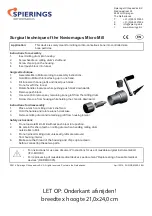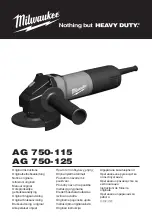
English
24
motion otherwise kick-back may occur.
Investigate and take cor-
rective action to eliminate the cause of wheel binding.
d)
Do not restart the cutting operation in the workpiece. Let the
wheel reach full speed and carefully reenter the cut.
The wheel
may bind, walk up or kickback if the power tool is restarted in the
workpiece.
e)
Support panels or any oversized workpiece to minimise the risk
of wheel pinching and kick-back.
Large workpieces tend to sag
under their own weight. Supports must be placed under the work-
piece near the line of cut and near the edge of the workpiece on
both sides of the wheel.
f)
Take extra caution when making a “pocket cut” into existing
walls or other blind areas.
The protruding wheel may cut gas or
water pipes, electrical wiring or objects that can cause kickback.
Safety Warnings Specific for Sanding
Operations:
a)
Do not use excessively oversized sanding disc paper. Follow
manufacturers recommendations when selecting sanding
paper.
Larger sanding paper extending beyond the sanding pad
presents a laceration hazard and may cause snagging, tearing of
the disc or kickback.
Safety Warnings Specific for Wire Brushing
Operations:
a)
Be aware that wire bristles are thrown by the brush even dur-
ing ordinary operation. Do not overstress the wires by applying
excessive load to the brush.
The wire bristles can easily penetrate
light clothing and/or skin.
b)
If the use of a guard is recommended for wire brushing, do not
allow any interference of the wire wheel or brush with the
guard.
Wire wheel or brush may expand in diameter due to work
load and centrifugal forces.
Charger safety warnings
– This appliance is not designed for use by other people (children
included), physical, sensory or mental incapability or lack of ex-
perience and knowledge of whose prevent from safe use of the
appliance without being supervised, or without being instructed
on use of the appliance by a person responsible for their safety.
– Children should be supervised to avoid their playing with the ap-
pliance.
Information about noise level
and vibrations
The values have been measured in conformity with EN 60745-1.
ABU 230-600 B
Acoustic pressure level L
pA
= 89.1 dB (A).
Acoustic power level L
wA
= 100.1 dB (A).
In accuracy of measurements K = 3.0 dB (A).
ATTENTION! Noise is generated during work!
Use ear protection!
The weighted value of vibrations affecting hands and arms a
h
= 7.36 m.s
-2
.
In accuracy of measurements K = 1.5 m.s
-2
.
The emission values specified (vibration, noise) were measured in ac-
cordance with the test conditions stipulated in EN 60745 and are intend-
ed for machine comparisons. They are also used for making preliminary
estimates regarding vibration and noise loads during operation.
The emission values specified refer to the main applications for which
the power tool is used. If the electric power tool is used for other ap-
plications, with other tools or is not maintained sufficiently prior to
operation, however, the vibration and noise load may be higher when
the tool is used.
Take into account any machine idling times and downtimes to estimate
these values more accurately for a specified time period. This may signif-
icantly reduce the load during the machine operating period.
Double insulation
To ensure maximum safety of the user our tools are designed and built
to satisfy applicable European standards (EN standards). Tools with
double insulation are marked by the international symbol of a double
square. These tools must not be grounded and a two-wire cable is suffi-
cient to supply them with power. Tools are shielded in accordance with
EN 55014.
Use
The machine is designed for cutting, roughing and brushing metal and
construction materials without the use of water. When cutting construc-
tion material, ensure sufficient dust extraction and always clean the ma-
chine after work (cleaning with compressed air recommended).
The user bears full responsibility for the consequences of using the ma-
chine for purposes it was not designed for.
Accumulator Battery Charge
Instructions
1. Please make sure that the mains voltage is the same as the voltage
listed on the machine plate on the charger. First, plug the power
cable (18b) into the charger (18a), then connect the charger (18a)
to power supply. A red LED indicator (19) will light up. This means
that the charger is ready to charge. Check the connection to power
supply if the red LED indicator does not light up. If power supply
is in order, bring the charger in for repair to an authorised service
centre!
2. Slide the battery (1) into the charger all the way.
3. The red LED indicator light turns off and a green LED indicator
light (19) begins blinking, indicating that the battery is in fast
charge mode.
4. The battery is fully charged after about 60 to 80 minutes (depend-
ing on the battery capacity) once the green LED indicator light
stops blinking and remains lit.
5. Disconnect the battery from the charger. If you do not wish to
charge another battery, disconnect the charger from the power
source.
An overview of charging LED indicator lights (19):
Green LED indicator
Red LED indicator
Signal combinations
Is off
Is on (constant light)
Connected to power*
Is on and is blinking
Is off
The battery is charging
Is on (constant light)
Is off
The battery is charged
Is on and is blinking
Is on and is blinking
The temperature of the
charger or the battery is
too high
Is off
Is on and is blinking
The battery is damaged
* When the charger is activated after it is connected to power, the red and the
green LED indicator lights will blink for about 1 second, then the red LED indica‑
tor light will stop blinking and remain on (constant light).
New batteries:
Battery capacity may be slightly smaller than the listed value during the
first few initial charge cycles. The reason is that the chemical composi-
tion of the batteries has not been activated yet. This is a temporary issue
and will resolve on its own after a few charge cycles.
Note:
• A blinking green indicator means that the battery is fully charged or
that it is in slow charge mode, which maintains a low charge level of
the battery.
• The initial battery charge may take longer thAN 60 to 80 minutes
(according to battery capacity) depending on the environment
temperature, the power supply and the current charge level.
• If you are not using the charger, please unplug it from the power
source.
Important information about the charging
process:
1. To get the best out of the batteries in terms of longevity and per-
formance is to charge them at an ambient temperature of 18 °C
to 24 °C.
DO NOT CHARGE
the batteries at temperatures below
0 °C and above 45 °C. This is very important. You will prevent serious
battery damage.
• Do not charge the batteries in direct sunlight, especially in the sum-
mer! You will prevent extreme overheating, which could damage
them!
2. If a battery that is too cold (below 0 °C) is inserted into the charg-
er, the charger will not begin charging it right away; instead, the
green and the red indicator light will begin blinking. Once the bat-
tery reaches the right temperature naturally (within the standard
range), the fast charge process will begin automatically.
• If a battery that is too hot (more than 45 °C), is inserted into the
charger, the charger will not begin charging it right away; instead,
the green and the red indicator light will begin blinking. Once the
Содержание ABU 230-600 B BASIC
Страница 4: ...4 17b 17a 16a 17 2 1 16 22 5a 4 3 8 15a 11 15 5 7b 6 7a 12 12 10a 13 13a 20 14b 14a 10b 13 13a 21...
Страница 5: ...5 10 6 8 5 9b 7b 9a 1 2 19 18a 18b...
Страница 13: ...esky 13...
Страница 62: ...o 62 4 a 5 a a...
Страница 63: ...o 63 a...
Страница 66: ...o 66 13 13a 20 1 1 2 4 3 3 16 80 1 17 17a 17 17b 3 100 2 60 1 30 22 20 C 50 C...
















































